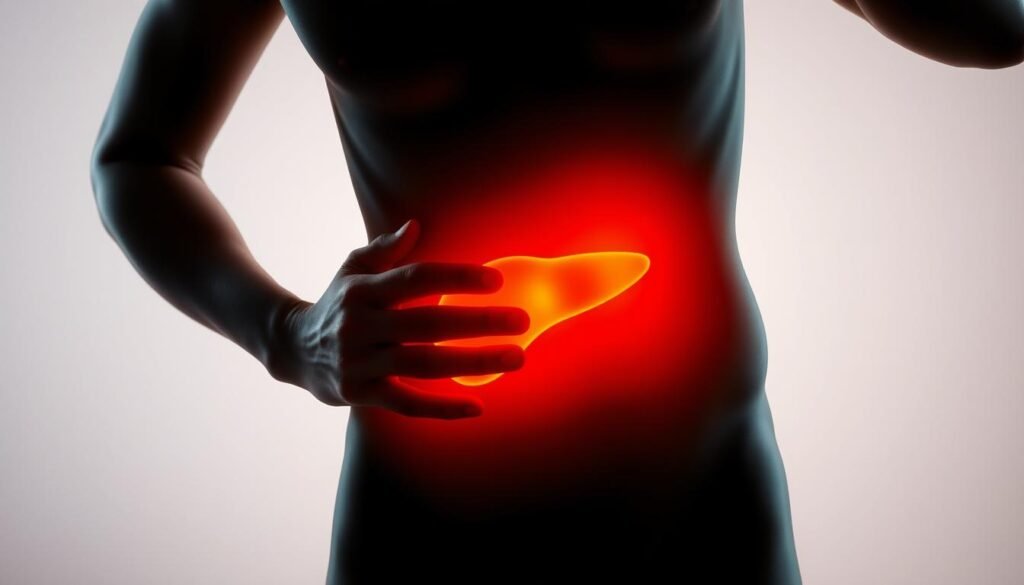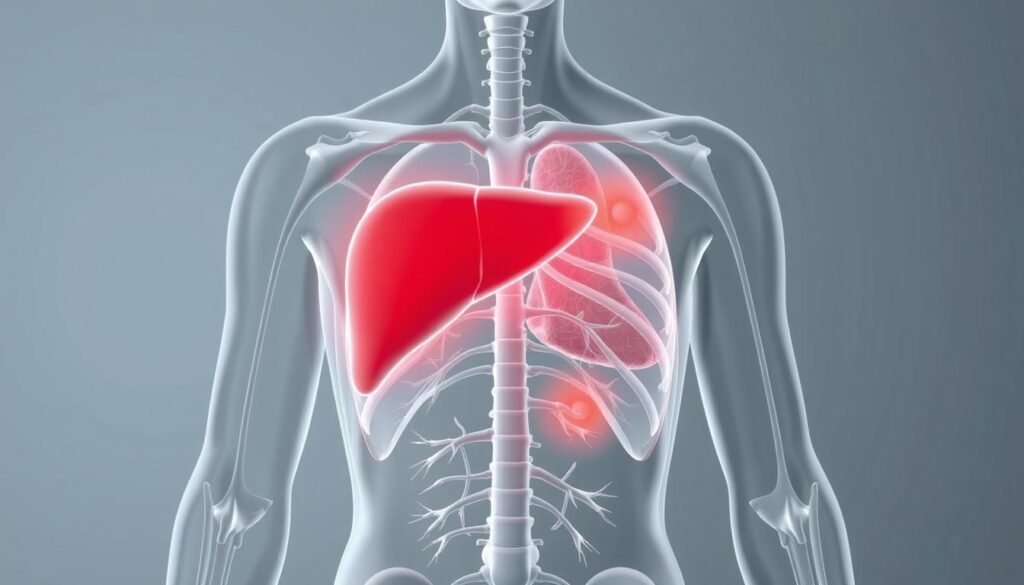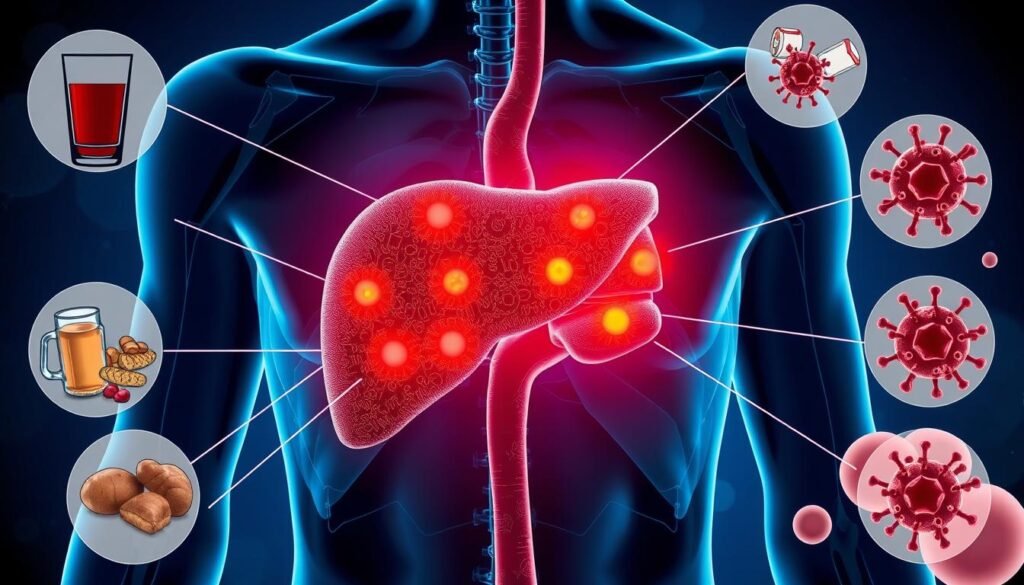Did you know a big number of people with cirrhosis feel a dull or throbbing pain? Around 4.5 million Americans live with liver disease. That’s about 2% of adults. It’s important to know where liver pain happens and how to spot it. Liver pain is often hard to figure out. It’s vague, making it tough for people to know exactly where it hurts.
Liver pain is usually felt in the upper right abdomen. But it might also spread to the shoulders or back. People can feel it differently. It could be dull aches, sharp pains, or even a feeling of fullness. Because of this, knowing the signs of liver pain is key. It helps with getting the right diagnosis and treatment. This way, people can look after their liver health better.
Key Takeaways
- Liver pain often occurs in the upper right abdomen.
- More than 80% of those with cirrhosis report dull or throbbing pain.
- Symptoms of liver pain can vary significantly from person to person.
- Understanding liver pain location is essential for effective treatment.
- Recognizing liver pain symptoms can lead to earlier medical evaluations.
Understanding the Liver and Its Functions
The liver is a vital organ with many jobs, crucial for a healthy body. It helps us stay well every day. Knowing what it does shows us why it’s so important.
The Role of the Liver in the Body
The liver is big, about three pounds in adults, and does a lot for our health. It holds a pint of blood and cleans it. The blood from our stomach and intestines goes through the liver. There, it filters out toxins and bad stuff.
This organ also helps our blood clot. That way, we can heal properly from cuts or injuries.
Common Functions of the Liver
The liver has over 500 important jobs. Here are a few:
- Production of bile, necessary for fat digestion
- Storage of nutrients like vitamins and minerals
- Processing medications and drugs, clearing them from the bloodstream
- Regulating blood sugar levels and metabolism
- Supporting immune function by filtering bacteria and pathogens from the blood
Knowing what the liver does helps us understand how to keep it healthy. Diseases like alcoholic liver disease and fatty liver disease can affect its work. So can genetic issues like hemochromatosis and Wilson disease, plus infections like hepatitis. Being aware helps us care for our liver and live healthily.
| Function | Description |
|---|---|
| Bile Production | Helps digest fats and eliminate waste from the body. |
| Blood Clotting Regulation | Ensures proper blood coagulation during injuries. |
| Toxin Removal | Filters drugs and toxins from the bloodstream. |
| Nutrient Storage | Holds essential nutrients like vitamins and minerals for later use. |
| Metabolism Support | Regulates blood sugar and overall metabolism in the body. |
Where Does Liver Pain Hurt?
Liver pain is tricky to figure out because it shows up in places you wouldn’t expect. The liver itself doesn’t feel pain. But liver issues can cause discomfort in different parts of your body. Knowing where liver pain usually happens can help you spot problems early.
Typical Locations of Liver Pain
Liver pain is often felt in the upper right side of the belly, just under the ribs. This pain can feel like a dull ache or a sharp stab. It might even spread to other places, making it hard to know where it’s coming from. Liver swelling or pressure on nearby tissues can make the pain worse.
Associated Pain in Other Areas
Pain from liver issues might also show up in your shoulders, back, and neck. Problems like gallstones or fatty liver disease can cause similar pain. This can lead to wrong diagnoses. For example, sudden upper belly pain might seem like liver trouble, but it could be your gallbladder. It’s important to understand these differences and get checked by a doctor if you’re worried. For more on liver-related skin issues, see this detailed resource.

Recognizing Liver Pain Symptoms
Liver pain symptoms can indicate liver problems. It’s important to know these signs early. People may feel dull aches, fullness, or sharp pains in their stomach.
Knowing these symptoms can help spot liver issues early.
Common Symptoms of Liver Pain
Liver damage symptoms include:
- Jaundice (yellowing of the skin and eyes)
- Dark urine
- Swelling in the abdomen or limbs
- Persistent fatigue or exhaustion
- Loss of appetite
- Unexplained weight loss
- Nausea or vomiting
- Itchy skin
- Easy bruising
As liver issues get worse, pain can increase. Regular check-ups can prevent problems from getting serious.
How Symptoms May Vary Based on Condition
The type and intensity of symptoms change with different liver diseases. For example, cirrhosis might not show early signs but later causes a lot of pain. Fatty liver disease can lead to more severe symptoms if it turns into cirrhosis.
Sharp, severe pains may come from urgent conditions like acute cholangitis. Pain in joints and muscles can also happen due to liver disease. For more on liver issues and muscle pain, see this link.

Common Causes of Liver Pain
Liver pain can come from different conditions. It’s important to know these causes to treat and manage them correctly. Inflammatory liver disease is a major issue, causing health problems and complications.
Inflammatory Conditions
Inflammatory liver disease leads to liver discomfort. Hepatitis, caused by viruses or alcohol, hurts liver function and causes pain. Drinking too much can make your liver inflamed and scarred, this is called cirrhosis. About 80% of people with cirrhosis feel pain.
Nonalcoholic fatty liver disease is also a problem. It’s getting more common due to obesity. Too much fat in liver cells leads to inflammation and pain. Infections like mononucleosis or parasites can also make your liver hurt.
Other Medical Issues Affecting the Liver
Other medical problems can cause liver pain too. Gallstones can block bile ducts, leading to serious pain in the stomach area. Liver cancer, which needs quick action, can also show up as liver pain. Conditions like pancreatitis can inflame your pancreas and affect your liver too.
Sometimes, muscle strain in the belly can feel like liver pain. This happens because of where the liver is in your body. Knowing all these causes helps doctors find the right diagnosis and treatment.

| Condition | Details | Pain Percentage |
|---|---|---|
| Cirrhosis | Liver scarring due to inflammation | 80% |
| Hepatitis | Inflammation caused by viral infections or alcohol | Varies |
| Nonalcoholic Fatty Liver Disease | Excess fat in liver cells without alcohol use | Varies |
| Liver Cancer | Malignant growths requiring urgent care | Varies |
| Gallstones | Blockage in bile ducts causing pain | Varies |
Diagnosis of Liver Pain
To figure out the cause of liver pain, a thorough check-up is needed. This includes looking you over and knowing your health history. Finding the problem early helps treat liver issues before they get worse. Also, different tests help find if there’s liver disease.
Importance of Medical Evaluation
If you feel liver pain, seeing a doctor fast is important. The symptoms can mean many things and might need quick action. Making healthy life choices, like eating right and not drinking too much alcohol, is key for your liver.
Common Diagnostic Tests for Liver Conditions
Doctors use some common tests to check on the liver:
| Test Type | Description | Purpose |
|---|---|---|
| Blood Tests | Evaluates liver function and checks for enzymes indicating inflammation. | Detect liver disease or damage. |
| Imaging Tests | Includes ultrasounds, CT scans, and MRIs to visualize liver structure. | Identify liver damage or abnormalities. |
| Liver Biopsy | Involves taking a sample of liver tissue for laboratory analysis. | Diagnose specific liver diseases. |
Making lifestyle changes is suggested by the American Liver Foundation to boost liver health. Liver pain might point to long-term problems. It’s important to take tests and check-ups seriously. To learn more about what causes liver pain, you can check out this resource.
Liver Pain Treatment Options
Treating liver pain depends on the cause. A mix of home remedies and medical treatments usually works best. This approach helps people with liver disease feel better. Changing your lifestyle and getting medical care can improve your liver health.
Home Remedies and Lifestyle Changes
Simple lifestyle changes can ease liver discomfort. Here are some key tips:
- Maintaining a balanced diet: Eating fruits, vegetables, and whole grains supports your liver.
- Staying hydrated: Water helps with digestion and removes toxins.
- Regular exercise: Staying active keeps your weight in check and fights fatty liver disease.
- Avoiding substances: Avoid alcohol and some medications to ease liver stress.
Medical Treatments for Liver Pain
The treatment for liver pain varies by condition. Options may include:
- Antiviral therapies: These help people with hepatitis. They lower virus levels and improve liver health.
- Medications for symptom management: Use pain relievers like acetaminophen carefully. Doses over 2 g a day can harm the liver, especially if you’re already sick.
- Alternative medications: Gabapentin, pregabalin, and some antidepressants are safer. They help with chronic pain.
- Surgical interventions: Surgery may be the best option for serious cases, like tumors or major liver damage.
Managing Severe Liver Pain
Severe liver pain could mean something serious is happening. It is crucial to see a doctor quickly. Fast help can make a big difference.
Identifying Severe Symptoms
If you have bad liver pain, watch for certain dangerous signs. You might need urgent help if you see them:
- Acute abdominal pain, which may be sharp and persistent
- Vomiting blood, a serious sign of gastrointestinal bleeding
- Jaundice, characterized by yellowing skin and eyes
- Rapid deterioration in health or overall weakness
Knowing these signs helps you realize when to get emergency care. If you ignore them, it could lead to big problems.
When to Seek Emergency Care
If your liver pain is really bad, don’t wait to get help. Doctors say to go to the ER if you notice serious symptoms.
Not getting help soon can be very risky. In the U.S., liver disease is a big problem. It causes a lot of deaths each year. Illnesses like cirrhosis make many people suffer from liver pain. In bad cases, treatments like liver dialysis or a transplant may be needed.
| Symptom | Recommended Action |
|---|---|
| Acute abdominal pain | Seek immediate medical attention |
| Vomiting blood | Go to the nearest emergency room |
| Jaundice | Consult a healthcare professional |
| Rapid health deterioration | Request emergency assistance |
Knowing about severe liver pain and acting fast can save lives. Learn the symptoms and how to respond. This way, you can get the care you need right away.
Liver Pain Management Strategies
Managing liver pain includes different tactics. These focus on quick relief and long-term health. Lifestyle changes and preventive steps are key for a healthy liver. Learning how to take care of your liver helps you stay well. It may also lower liver pain.
Preventive Measures for Liver Health
Preventing liver problems is important. Several strategies help avoid liver issues:
- Avoiding excessive alcohol consumption: Drinking less alcohol cuts the risk of liver diseases like cirrhosis.
- Eating a balanced diet: Good nutrition supports the liver. Eat plenty of fruits, veggies, whole grains, and lean proteins.
- Regular exercise: Being active helps keep a healthy weight and boosts liver health.
- Staying hydrated: Drinking enough water is good for your body and liver.
- Monitoring chronic conditions: Managing diseases like diabetes is crucial for liver care.
Maintaining a Healthy Lifestyle
To manage liver pain well, a healthy lifestyle is important. This includes:
- Routine check-ups: Seeing your doctor regularly helps catch liver problems early.
- Educating oneself: Knowing about liver diseases helps you make smart health choices.
- Implementing stress-reduction techniques: Yoga or meditation can improve your overall health, helping your liver.
- Avoiding self-medication: Always talk to a doctor before taking new medicines to avoid harming your liver.
By adding these strategies to your life, you can boost your liver health and manage liver pain better. Being proactive leads to a better life and protects against liver problems.
| Healthy Lifestyle Practice | Impact on Liver Health |
|---|---|
| Avoiding Alcohol | Reduces risk of liver disease |
| Balanced Diet | Supports liver function and reduces fat accumulation |
| Regular Exercise | Maintains healthy weight and improves overall health |
| Staying Hydrated | Aids in liver detoxification processes |
| Routine Check-ups | Facilitates early detection of liver issues |
Conclusion
Liver pain can be complex but understanding it is key. People with liver issues often feel a dull or throbbing pain. This pain is usually in the upper-right part of the stomach.
About 80% of people with cirrhosis or fatty liver feel pain. It’s important to act quickly if you have these conditions. Jaundice, feeling sick, and losing weight without trying are signs to watch for. If you notice these, seek medical help right away. For more information, check this resource.
Knowing about liver pain is step one towards getting the right treatment. It’s good to take steps to keep your liver healthy. Things like eating well and not drinking too much alcohol help.
Regular exercise and health check-ups are great for your liver and overall health. Taking these actions can make a big difference.
Educating yourself and taking early action is key to a better life. With the right knowledge, you can look after your liver better. This helps keep your liver working well and lowers the risk of serious problems.